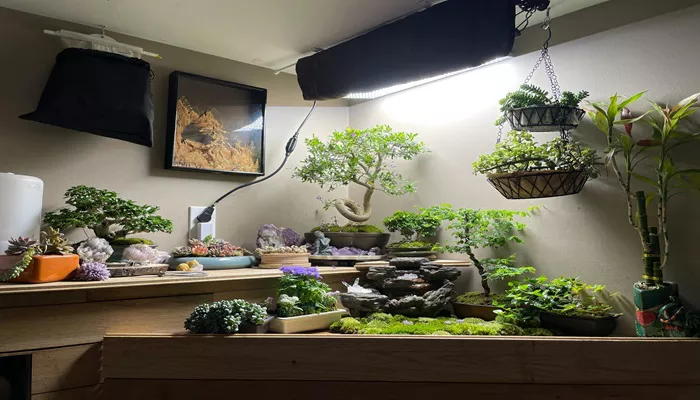Growing indoor bonsai is an art form that combines patience, skill, and the right care to create stunning miniature trees. One of the most critical aspects of maintaining healthy bonsai is providing the right nutrients through fertilization. In this article, we will explore the best fertilizers for indoor bonsai, focusing on their types, application methods, and essential tips for achieving vibrant growth and beautiful foliage.
Understanding Bonsai Nutritional Needs
Bonsai trees, like all plants, require a balanced diet of essential nutrients to thrive. These nutrients are typically categorized into macronutrients and micronutrients:
Macronutrients
Nitrogen (N): Crucial for leaf and stem growth, nitrogen encourages healthy green foliage.
Phosphorus (P): Important for root development and flowering, phosphorus helps the tree establish a strong foundation.
Potassium (K): Essential for overall plant health, potassium aids in water regulation, disease resistance, and fruiting.
Micronutrients
While required in smaller amounts, micronutrients play vital roles in bonsai health:
Iron (Fe): Promotes chlorophyll production and prevents yellowing leaves.
Magnesium (Mg): Aids in photosynthesis and overall growth.
Calcium (Ca): Important for cell wall structure and overall plant vigor.
Bonsai trees require a balance of these nutrients to flourish. Understanding their needs helps in selecting the right fertilizer for your indoor bonsai.
Types of Fertilizers
When choosing a fertilizer for your indoor bonsai, several types are available, each with its benefits and drawbacks.
1. Liquid Fertilizers
Liquid fertilizers are easy to apply and quickly absorbed by the roots. They are ideal for bonsai trees that need a quick nutrient boost. Some popular options include:
Fish Emulsion: Rich in nitrogen and micronutrients, fish emulsion is an organic option that promotes healthy growth.
Seaweed Extract: Known for its growth hormones, seaweed extract supports root development and enhances resistance to stress.
Balanced Liquid Fertilizers: Formulations like 20-20-20 (N-P-K) provide a balanced mix of nutrients for all-around health.
Application Tip: Dilute the liquid fertilizer according to the manufacturer’s instructions and apply it every 2-4 weeks during the growing season (spring and summer).
2. Granular Fertilizers
Granular fertilizers release nutrients slowly, providing a steady supply over time. They are excellent for bonsai enthusiasts who prefer less frequent applications. Key options include:
Slow-Release Fertilizers: Formulated with a controlled-release mechanism, these fertilizers can last up to several months. Look for balanced options with equal parts N-P-K, such as 10-10-10.
Organic Granular Fertilizers: Made from natural materials, these fertilizers improve soil health over time. Options like composted manure or bone meal provide essential nutrients while enhancing microbial activity in the soil.
Application Tip: Scatter the granular fertilizer evenly over the soil surface and water thoroughly to activate the release of nutrients.
3. Organic Fertilizers
Organic fertilizers are derived from natural sources and are often more environmentally friendly. They promote healthy soil biology and improve long-term plant health. Some popular organic options include:
Compost: Rich in nutrients and beneficial microorganisms, compost improves soil structure and fertility.
Worm Castings: These nutrient-rich byproducts of vermiculture enhance soil health and provide a balanced nutrient profile.
Bone Meal: High in phosphorus, bone meal encourages root development and flowering.
Application Tip: Mix organic fertilizers into the top inch of the soil before watering to ensure even distribution and uptake by the roots.
4. Fertilizer Spikes
Fertilizer spikes are convenient options for bonsai enthusiasts who want a low-maintenance approach. These pre-measured spikes release nutrients slowly over time. They are easy to use and can last several months.
Application Tip: Insert the spikes into the soil according to the package instructions, ensuring they are spaced evenly throughout the root zone.
When to Fertilize Indoor Bonsai
Timing is crucial for effective fertilization. Indoor bonsai typically grow most actively in spring and summer, making this the ideal period for fertilization. During the fall and winter, growth slows down significantly, and fertilization should be reduced or halted altogether.
Seasonal Fertilization Schedule
Spring (March to May): Start fertilizing as new growth emerges. Apply a balanced fertilizer every 2-4 weeks.
Summer (June to August): Continue fertilizing every 4-6 weeks, focusing on liquid fertilizers for quick absorption.
Fall (September to November): Gradually reduce fertilization as growth slows. Switch to a low-nitrogen fertilizer if necessary.
Winter (December to February): Avoid fertilization during dormancy, as the tree’s nutrient needs are minimal.
Tips for Fertilizing Indoor Bonsai
Test the Soil: Before fertilizing, consider testing the soil for nutrient levels. This will help determine if additional nutrients are needed.
Observe Your Bonsai: Monitor your bonsai for signs of nutrient deficiencies, such as yellowing leaves or stunted growth. Adjust your fertilization approach accordingly.
Watering: Always water your bonsai thoroughly before and after applying fertilizer. This helps prevent root burn and ensures even nutrient distribution.
Avoid Over-Fertilization: Too much fertilizer can lead to salt buildup in the soil, damaging the roots. If you notice white crust on the soil surface, consider flushing the soil with water to remove excess salts.
Adjust for Species: Different bonsai species have unique nutritional requirements. Research your specific tree type to determine the best fertilizer and application method.
see also: Can I Use Bonsai Soil for Aloe Vera?
Conclusion
Fertilizing your indoor bonsai is essential for promoting healthy growth and ensuring your tree thrives in its environment. By understanding the nutritional needs of your bonsai and selecting the appropriate fertilizer, you can create a vibrant indoor garden that showcases the beauty of these miniature trees.
Remember to choose the right type of fertilizer, adhere to a seasonal fertilization schedule, and follow best practices for application. With the right care and attention, your indoor bonsai will flourish, becoming a stunning centerpiece in your home. Happy gardening!


